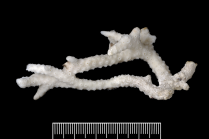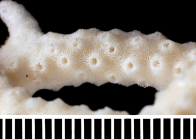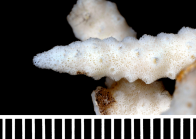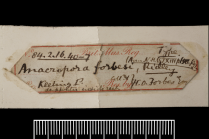
WoRMS taxon detailsAnacropora Ridley, 1884
206932 (urn:lsid:marinespecies.org:taxname:206932)
accepted
Genus
Anacropora forbesi Ridley, 1884 (type by monotypy)
marine,
Ridley, S.O. (1884). On the classificatory value of growth and budding in the Madreporaria and on a new genus illustrating this point. <em>Annals and Magazine of Natural History, 5th Series.</em> 13: 284-291. [details]
Description Colonies are arborescent with thin tapered branches, without axial corallites. All corallites are radial, and are small and...
Description Colonies are arborescent with thin tapered branches, without axial corallites. All corallites are radial, and are small and immersed. Septa are in two cycles with inward-projecting teeth. Columellae are absent. Corallite walls and the coenosteum are porous, without elaborations. Polyps are extended day and night and are widely spaced; they are small, with fine tentacles (Veron, 1986 <57>). [details]
Hoeksema, B. W.; Cairns, S. (2025). World List of Scleractinia. Anacropora Ridley, 1884. Accessed through: World Register of Marine Species at: https://www.marinespecies.org/aphia.php?p=taxdetails&id=206932 on 2025-05-03
Date action by 2006-09-05 08:30:55Z changed Martinez, Olga
Nomenclatureoriginal description
Ridley, S.O. (1884). On the classificatory value of growth and budding in the Madreporaria and on a new genus illustrating this point. <em>Annals and Magazine of Natural History, 5th Series.</em> 13: 284-291. [details] basis of record Veron JEN. (1986). Corals of Australia and the Indo-Pacific. <em>Angus & Robertson Publishers.</em> [details] Othercontext source (Hexacorallia)
Fautin, Daphne G. (2013). Hexacorallians of the World. (look up in IMIS) [details]
additional source Liu, J.Y. [Ruiyu] (ed.). (2008). Checklist of marine biota of China seas. <em>China Science Press.</em> 1267 pp. (look up in IMIS) [details] Available for editors additional source Veron JEN. (2000). Corals of the World. Vol. 1–3. <em>Australian Institute of Marine Science and CRR, Queensland, Australia.</em> [details] additional source Veron JEN, Wallace CC (1984) Scleractinia of Eastern Australia – Part V. Family Acroporidae. Australian Institute of Marine Science Monograph Series 6: 1–485. [details] additional source Duncan PM (1884) A revision of the families and genera of the sclerodermic Zoantharia, Ed. & H., or Madreporaria (M. Rugosa excepted). Journal of the Linnean Society of London, 18: 1-204. [details] additional source Forsman, Z. H.; Concepcion, G. T.; Haverkort, R. D.; Shaw, R. W.; Maragos, J. E.; Toonen, R. J. (2010). Ecomorph or endangered coral? DNA and microstructure reveal Hawaiian species complexes: Montipora dilatata/flabellata/turgescens & M. patula/verilli. Public Library of Science One, 5, 12, 1-10 page(s): 4 [details] additional source Dunn, D. F. (1982). Cnidaria. McGraw-Hill Book Company. New York and other cities., volume 1, pp. 669-706 page(s): 701 [details] additional source Neave, Sheffield Airey. (1939-1996). Nomenclator Zoologicus vol. 1-10 Online. <em>[Online Nomenclator Zoologicus at Checklistbank. Ubio link has gone].</em> , available online at https://www.checklistbank.org/dataset/126539/about [details]  Present Present  Inaccurate Inaccurate  Introduced: alien Introduced: alien  Containing type locality Containing type locality
Unreviewed
Description Colonies are arborescent with thin tapered branches, without axial corallites. All corallites are radial, and are small and immersed. Septa are in two cycles with inward-projecting teeth. Columellae are absent. Corallite walls and the coenosteum are porous, without elaborations. Polyps are extended day and night and are widely spaced; they are small, with fine tentacles (Veron, 1986 <57>). [details]Remark Type species: Anacropora forbesi Ridley, 1884 (Veron, 1986). [details] |




